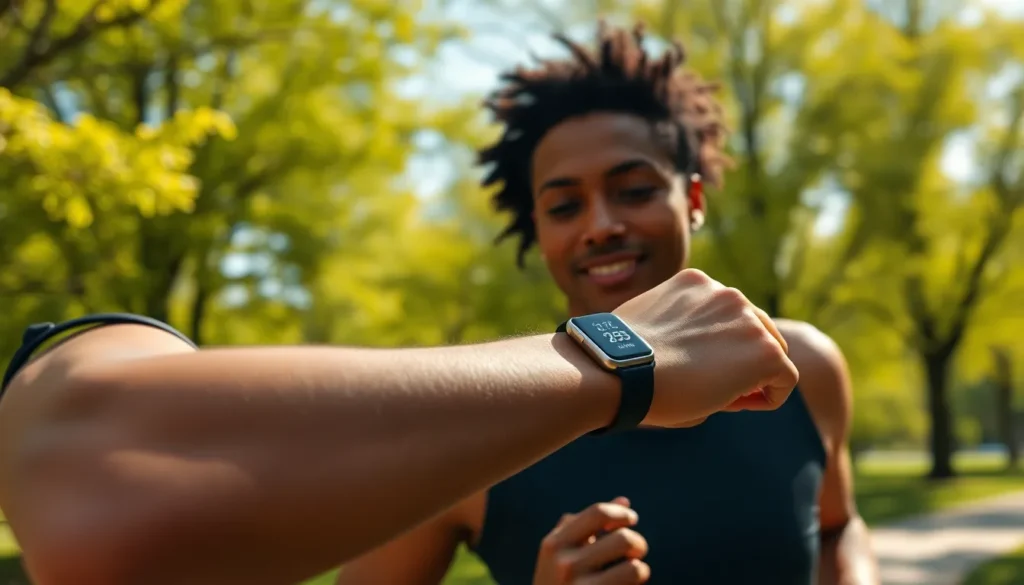Table of Contents
ToggleWearable health tech is revolutionizing the way people monitor their wellness and fitness. From smartwatches that track heart rates to fitness bands that log daily activity, these devices empower users to take charge of their health like never before. With technology advancing at breakneck speed, it’s easier than ever to access real-time data about one’s body.
As awareness of health and fitness grows, so does the demand for innovative solutions that fit seamlessly into daily life. Wearable devices not only provide valuable insights but also motivate users to achieve their health goals. This article explores the latest trends in wearable health technology, highlighting how these gadgets are shaping the future of personal health management.
Overview of Wearable Health Tech
Wearable health technology encompasses devices designed to monitor health metrics seamlessly. These devices include smartwatches, fitness trackers, and health-monitoring clothing. Users access real-time data on heart rate, sleep patterns, physical activity, and more, promoting informed decision-making regarding health and fitness.
Market growth in wearables reflects rising consumer interest. In 2022, global revenues for the wearable tech industry reached approximately $52 billion, with projections to exceed $85 billion by 2028. Major brands like Apple, Fitbit, and Garmin lead the market, constantly innovating features such as stress management tools, blood oxygen monitoring, and ECG capabilities.
Technological advancements enhance the functionality of wearable devices. Many now integrate artificial intelligence and machine learning to provide personalized health insights. These advancements enable more accurate tracking and facilitate proactive health management.
Wearable health tech demonstrates versatility, catering to diverse user needs. Athletes leverage wearables for performance tracking, while individuals with chronic illnesses benefit from continuous monitoring. The accessibility of these devices encourages preventive healthcare practices across various demographics.
Regulatory bodies also influence the evolution of wearable health technology. Organizations like the U.S. Food and Drug Administration (FDA) provide guidelines ensuring safety and efficacy, fostering consumer trust. Compliance with these standards enhances the credibility of health tech products in the marketplace.
Overall, wearable health technology significantly impacts personal wellness management, providing users with tools to enhance their health awareness and lifestyle choices. As innovation continues, its role in health management is likely to expand, catering to an even broader audience.
Types of Wearable Health Tech

Wearable health technology encompasses various devices designed to monitor health metrics and enhance wellness. Key categories include fitness trackers, smartwatches, and medical devices, each serving distinct purposes to address user needs.
Fitness Trackers
Fitness trackers monitor physical activity and health metrics. Common features include step counting, heart rate monitoring, and calorie tracking. Devices like Fitbit Inspire and Garmin Vivosmart provide real-time feedback, motivating users to achieve fitness goals. Many fitness trackers also track sleep patterns, helping individuals understand their rest quality, which contributes to overall health.
Smartwatches
Smartwatches combine the functionalities of fitness trackers and smartphones. They allow users to receive notifications, manage calls, and access apps while monitoring health metrics. Popular models, such as the Apple Watch and Samsung Galaxy Watch, offer advanced features like ECG monitoring and blood oxygen level tracking. These devices often include customizable watch faces and activity reminders, promoting an active lifestyle.
Medical Devices
Medical wearable devices focus on health monitoring and management for specific medical conditions. Products like continuous glucose monitors (CGMs) aid diabetics by providing real-time glucose level data. Smart inhalers and heart monitor wearables also exist, enabling patients to track chronic conditions efficiently. These devices often require regulatory approval to ensure they meet safety and efficacy standards, providing users with reliable health data.
Benefits of Wearable Health Tech
Wearable health technology offers various advantages that enhance personal wellness and fitness. These devices provide users with tools to monitor their health proactively and improve their overall quality of life.
Improved Health Monitoring
Improved health monitoring is one of the primary benefits of wearable health tech. Devices continuously track metrics such as heart rate, blood pressure, and sleep quality. With real-time data, users identify health issues early and make informed decisions. For instance, many fitness trackers send alerts if heart rates exceed predetermined limits, prompting users to take necessary actions. Additionally, wearables capture data over time, enabling trends analysis and revealing personalized insights.
Enhanced Fitness and Wellbeing
Enhanced fitness and wellbeing stem from the motivational features of wearable health tech. These devices often incorporate goal-setting functionalities, allowing users to establish fitness objectives, such as daily step counts or workout durations. With performance metrics and progress tracking, users maintain motivation and adjust their routines accordingly. Moreover, some devices provide guided workouts and reminders, encouraging consistent exercise. As a result, users find improved physical health alongside mental wellbeing, as adherence to fitness regimens reduces stress levels and enhances mood stability.
Challenges and Concerns
Wearable health technology introduces several challenges and concerns that users and developers must navigate. Key issues include data privacy and accuracy, which significantly impact user experience and trust.
Data Privacy Issues
Data privacy ranks as a major concern for wearable health tech users. Devices collect sensitive health information, including heart rates and sleep patterns. Manufacturers often share this data with third parties, increasing the risk of unauthorized access or breaches. A survey by the Pew Research Center indicates that 79% of Americans express concerns about how personal data is used by companies. Users must carefully evaluate privacy policies and data protection measures before adopting these technologies.
Accuracy and Reliability
Accuracy and reliability pose additional challenges for wearable devices. Users rely on precise data for health management; however, the accuracy of sensors can vary significantly among devices. A study published in the Journal of Medical Internet Research found that some fitness trackers can misestimate calorie expenditure by as much as 40%. Without strict regulatory oversight, inaccuracies may lead to misguided health decisions. Manufacturers must ensure that devices meet robust performance standards to foster trust and promote widespread adoption.
Future Trends in Wearable Health Tech
Wearable health technology is poised for significant advancements in the coming years. Predictions indicate increased integration of advanced sensors, enabling real-time health monitoring. Devices will likely include capabilities for measuring blood pressure, glucose levels, and hydration status, providing comprehensive health insights.
Developments in artificial intelligence and big data analytics will enhance personalization in wearable devices. Personalized recommendations and health insights will become standard features, allowing users to receive tailored guidance based on their unique health profiles. These innovations will foster a more proactive approach to health management.
The incorporation of augmented reality (AR) and virtual reality (VR) technologies presents additional possibilities. Wearables equipped with AR can overlay health information in real time, allowing users to visualize their fitness data while exercising. VR applications may facilitate immersive workout experiences, promoting engagement and adherence to fitness routines.
Additionally, an increase in interoperability among devices is expected. Cross-platform compatibility will streamline data sharing between wearable devices and health management applications. Users will benefit from seamless integration of data across various platforms, leading to more informed health decisions.
As health regulations evolve, wearable devices are likely to undergo more rigorous testing processes. Enhanced regulatory frameworks will ensure safety and efficacy, instilling greater consumer confidence. This emphasis on trustworthiness will drive higher adoption rates and wider acceptance of wearable health tech in daily life.
Ultimately, trends shape future innovations in wearable health technology, empowering users with more accurate, personalized, and convenient health monitoring solutions. The evolution of this sector holds the potential to transform health management and improve quality of life for individuals globally.
Wearable health technology is revolutionizing how individuals approach their wellness and fitness journeys. As these devices become more advanced and user-friendly, they empower users to take charge of their health like never before. The integration of cutting-edge features and real-time tracking capabilities is not only enhancing personal health management but also fostering a greater awareness of individual well-being.
While challenges such as data privacy and accuracy remain critical concerns, ongoing advancements in technology promise to address these issues. The future of wearable health tech looks bright with potential innovations set to redefine health monitoring. As users embrace these tools, they can expect a more informed and proactive approach to their health, ultimately leading to improved quality of life.







